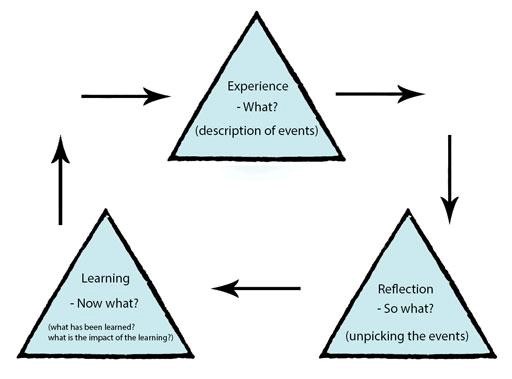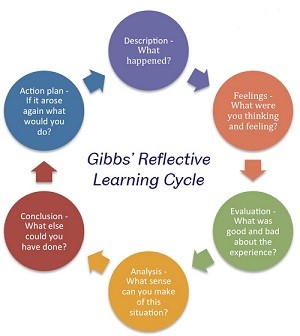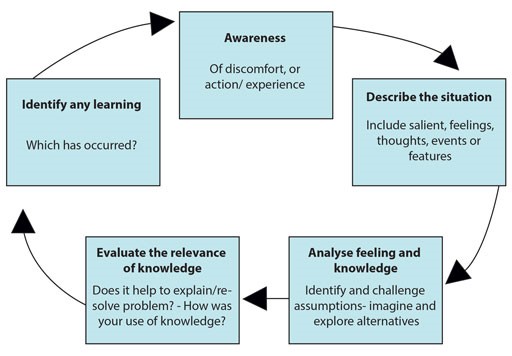Table of Contents
Introduction. 2
Theories of reflection. 2
- Boud’s triangular representation. 2
- Gibbs’s reflective cycle. 4
- Cyclic model of Atkins and Murphy. 5
Individual Reflection. 7
Example. 8
Conclusion. 8
References. 9
Introduction
The term reflective writing refers analytical exercise in which writer discusses his or her experience about an interaction, event, memory, passing thought, form in a form of personal reflection by elaborating thought, incident, feeling, situation or emotion (Brockbank, et al., 2017). The reflective report is a way of summarising the critical reflection of an individual. This reflective report aims to put reflection on my activities while completing the module which was focus on the ways of developing critical reflection.
In this module, I have also learned the ways of leading people. The different theories that can be used for writing critical reflection was also taught in the module and will discuss in this report such as Gibb’s cycle. This report will also shed light on the leader style which I am using presently along with the kind of leader I will become in future.
This report also reflects my learning from the activities of module and the weakness in my skill which prohibits my ability of performing certain activities. In this critical reflection, I will focus on discussing my strength and weakness along with the learning of skills that were require in making decision and solving problem in the module.
Theories of reflection
1. Boud’s triangular representation
As per Horton-Deutsch and Sherwood, (2017), reflective writing is recapturing the experience of oneself, thinking about it, mulling over it and then evaluating it. The process of evaluation involves re-examination of one’s experience in the shed of intent and prevailing knowledge. The Boud’s triangular representation mode is the simplest wat of reflective writing (Gibson, et al., 2017). The only disadvantage of this model is it cannot provide guidance to the learners about the ways by which they can use their learning into experiences.
The figure 1. illustrates the three stages of this model: experience, reflection and learning. The first stage is experience in which in which an individual elaborates the event. The second stage is the reflection in which the individual unravels the event. Learning in the last stage in which the individual discusses their learning from the event and its influence (Winstone and Boud, 2019).

Figure 1: Boud’s triangular representation
Source: intranet.umanitoba.ca
If I use this model for reflecting my learning than following is my reflection:
- Experience: the event upon which I am writing the reflection is an assignment which I had completed with my team on tourism. While working on the assignment, I was chosen as leader of team for the effective team work.
- Reflection: the main hurdle in that assignment was every member of team was unaware about the methods by which it can be solved. As a leader of team, I took all responsibility of assignment and allot task to every member so that we can manage the time line.
- I did not task any members about their skill and abilities and assign them task randomly. Although they completed the task on time and we were able to complete the assignment on time. I have used the autocratic leadership as I made all the decision solely and restrict the participation of other members.
- Learning: while working in a team I have realised that there were some issues in team. The lack of communication is one of the main causes of conflict. Though, I managed the conflict by communicating with them by using non-verbal communication. I asked members to communicate with each other personally so that there will be comfort and understanding within team. My autocratic leadership style acted as a boom as they followed my instruction because of which I was able to resolve the conflict.
- This assignment has also provided me learning about the importance of communication as a problem-solving skill. The proper communication among the team members can eliminate and manage the conflict and also improve the efficiency of team work.
2. Gibbs’s reflective cycle
The reflective cycle of Gibb’s was founded in 1988 by Graham Gibbs for providing edifice to learn from the experiences (Wilson and Miller, 2018). It provides framework for evaluating experiences and the cyclic nature of it is suitable for the repeated experiences. The reflective writing with Gibbs cycle involves 6 stages that are description, feeling, evaluation, analysis, conclusion and action plan.
the first stage is description in which the individual describes his or her experience of a situation. The next stage is feeling in which the thoughts of oneself about the experience is discussed. At the evaluation stage, the individual evaluates both positive and negative of the situation and at the analysis stage, the individual interprets the experience (Kumar, 2016). The conclusion is the fifth stage at which one discuss the learning from the experience. Action plan is the last stage in which individual discusses the actions that he or she will in the similar satiation in future.

Figure 2: Gibb’s reflective cycle
Source: sheffield.ac.uk
If I use this model for reflecting my experience in the activities of module then I can say that the outcome of the activity was nor very effective for me.
The application of Gibb’s cycle for my experience is:
- Description: The activity of module was performed in a group in which some students were more knowledgeable than me. Initially the team had face conflicts because of lack of understanding between the team members and me. I excluded the ideas of team members and impose my ideas without consulting it with others in which some of them have better knowledge.
- Feelings: In that scenario, I was demotivated and worried. I was feeling bad and not able to perform properly in activity.
- Evaluation: the situation was not very good as I was treated like an outsider in team. The conflicts in the team cause delay in the task and we missed the deadline. I have learned that my leadership style which as autocratic is not very effective as I should have considered the suggestion of other member who had better knowledge.
- Analysis: in the team, it was my responsibility to eliminate the conflicts in the team which I realised late.
- Conclusion: I have realised from this incident that in a team, every member of team is equally important. I could use the Belbin model for managing team and decision-making skills for managing conflicts in the team.
- Action plan: in future if I will be in the similar situation, the I will use Belbin model for managing team and reducing conflicts. I will also change my leadership style to democratic for future. I will also become a democratic leader as the autocratic leadership is not suitable for my behaviour and skills.
3. Cyclic model of Atkins and Murphy
The cyclic model of Atkins and Murphy is a model of reflective practice in which an individual sojourn and think regarding the experience, analyse consciously about the decision-making skills and relate it with the experience (Marshall, 2019). Unlike the Gibb’s model, it provides a profound level of reflection and helps in avoiding the superficial response by identifying assumptions and challenges, exploring alternatives and evaluating impact.
This model has five stages that awareness, description of situation, analysis of knowledge and feeling, evaluation of relevance of identity, learning and knowledge (Fook, 2018). The first stage is awareness in which an individual elaborates the discomfort from the experience. The next stage is description of situation which involves feelings, features and thoughts. The third stage is analysis of the feeling in which the individual identifies the postulation and encounters (Porntaweekul, et al., 2016).
The fourth stage is evaluating the relevance of knowledge in which an individual analysis the ways by which the learnings can be used and was used in the experience. The identification of any learning is the last stage in which an individual evaluates his or her knowledge during the situation.

Figure 3: Cyclic models of Atkin’s and Murphy
Source: open.edu
If I use the cyclic model of Atkins and Murphy for reflecting the same situation which I have reflected by applying Gibb’s model then I can say that the main cause of my discomfort in the team is the presence of the more knowledgeable members in team.
- Awareness: The presence of them made me insecure about my position of leader in the team.
- Description of situation: while working n the team for performing activities of module, I was only focused on opposing the suggestion of others by showing any drawback.
- Analysis of knowledge and feelings: I though my such behaviour provides me support of team but the conflicts have been started in the team. In that situation, I have learned that I should identify a way of resolving conflicts as the entire team was opposing my every decision so I went to those members who are more experienced and apologised to them. My apology changed the behaviour of team and the situation became normal.
- Evaluation of relevance of knowledge: The experienced member of team was using democratic leadership style while I was using autocratic leadership style. They consider the suggestion of every team member before taking any decision and also admit their faults.
- Identification of learning: my important learning from this situation is that every member of team has equal say in the process of decision making.
After reflecting upon my experience from Gibb’s and Atkins and Murphy’s reflective model, I have learned that the leadership style which I wan to prefer in future is democratic. The presence of experience team members in my team has made me learned about democratic leadership. I have learned that the leaders with democratic style certain set of skills like enablement of followers, participative decision making and distribution of the leadership.
I have also realised that I do not possess any of the skills that are required to become democratic leader. Though I have effective problem-solving ability as I was able to eliminate the conflict within the team. In any team, the leader is not only responsible for leading team but also responsible for managing and eliminating conflicts in the team (Puni, et al., 2016). Therefore, beside of any style of leadership, the problem-solving ability is very important for a leader.
Individual Reflection
My reflection on the experience of working as a team leader on the assignment of tourism shows that beside of skills of problem solving, I do not have prime qualities that are required for being a leader. The emotional intelligence is one of such ability which I need to develop for being a leader. The emotional intelligence enables an individual to make decision without getting influence from stress, joy, depression, anger or sadness (Petrides, et al., 2016).
My lack of emotional intelligence is the one of the reason dur to which I felt insecure about my leadership. Hence, I need to develop some skills of leadership so that I can act effectively in the similar situation in future.
I will learn these skills by following way:
- Distribution of the leadership: In future, if I will be in the similar situation or team role than I will ask every member for the ideas. I will also involve every member in the process of decision making. Although, I will also not remain aware to not being manipulated by members as the main decision will be taken by me as a leader. The distribution of leadership does not mean that every decision must be taken within the team.
- Enablement of followers: while working in similar situation in future, I will also put responsibility of critical task on the team member on the basis of their skills and abilities. It enables them to think critically and also empower them. I will also support them in learning new skills for completing the task.
- Participative decision making: while making decision in a team, I will ensure the involvement of every team member in decision making. I will consider the solution provided by other team members and also implement it if they are better than mine.
- Emotional intelligence: it is also a skill which I also need to improve for better leadership and team work in future. I will read the books that are relevant for gaining emotional intelligence so that I will be able to control my emotions.
Example
The main cause due to which I chose to use democratic leadership style in future is by observing the change in behaviour of the team members towards me and towards the other members who use democratic style. After this incident I have also gathered knowledge about other democratic leaders such as Tommy Lasorda who is a successful coach, manager and base ball pitcher.
He used the democratic leadership and trust the judgement of players (Patapan, 2017). Muhtar Kent, who is CEO and chairman of Coca Cola is also a democratic leader. He always seeks the input from others for making key decisions. They have managed and lead their team with the democratic leadership and gained success for their organisation or team. In future, I want to work in an organisation and democratic leadership will help me in becoming an effective leader.
Conclusion
This report concludes that the reflective writing is an effective way of analysing the weakness and strengths in terms of knowledge and skills in an individual in the context of situation. The report has discussed three models which can be used for writing reflection. I have also used these models for reflecting the activities I have performed in the assignment. While reflecting on my experience, I have realised that I used the autocratic leadership style which helped in eliminating the conflict within the team but it is also the cause of raising conflicts in the team. While learning from this experience, I have realised that I want to practice the democratic style of leadership.
Although it has also seen from the reflection that I own very few qualities of becoming a democratic leader which is problem solving. I do not have the main qualities that are enablement of followers, participative decision making and distribution of the leadership along with emotional intelligence. Therefore, I need to develop these qualities and skills for being an effective leader in future. In this report, I have also discussed the method by which I will practice these skills in future while working in a team or as a leader. This report has also shown the example of some major personalities who has used the democratic leadership style for managing and leading their teams irrespective of their industries.
References
- Brockbank, A., McGill, I. and Beech, N., 2017. Reflective learning in practice. In Reflective learning in practice (pp. 18-28). Routledge.
- Fook, J., 2018. REFLECTIVE MODELS AND FRAMEWORKS IN PRACTICE. Methodologies for Practice Research: Approaches for Professional Doctorates, p.57.
- Gibson, A., Aitken, A., Sándor, Á., Buckingham Shum, S., Tsingos-Lucas, C. and Knight, S., 2017. Reflective writing analytics for actionable feedback.
- Horton-Deutsch, S. and Sherwood, G.D., 2017. Reflective practice: Transforming education and improving outcomes (Vol. 2). Sigma Theta Tau.
- Kumar, K., 2016. Reflection and its uses in Problem Solving and Personal Development. GRIN Verlag.
- Marshall, T., 2019. The concept of reflection: a systematic review and thematic synthesis across professional contexts. Reflective Practice, 20(3), pp.396-415.
- Patapan, H., 2017. Democratic leadership. In Islam Beyond Conflict (pp. 77-88). Routledge.
- Petrides, K.V., Mikolajczak, M., Mavroveli, S., Sanchez-Ruiz, M.J., Furnham, A. and Pérez-González, J.C., 2016. Developments in trait emotional intelligence research. Emotion Review, 8(4), pp.335-341.
- Porntaweekul, S., Raksasataya, S. and Nethanomsak, T., 2016. Developing Reflective Thinking Instructional Model for Enhancing Students' Desirable Learning Outcomes. Educational Research and Reviews, 11(6), pp.238-251.
- Puni, A., Agyemang, C.B. and Asamoah, E.S., 2016. Leadership styles, employee turnover intentions and counterproductive work behaviours. International Journal of innovative research and development, 5(1), pp.1-7.
- Sekarwinahyu, M., Rustaman, N.Y., Widodo, A. and Riandi, R., 2019, February. Development of problem based learning for online tutorial program in plant development using Gibbs’ reflective cycle and e-portfolio to enhance reflective thinking skills. In Journal of Physics: Conference Series (Vol. 1157, No. 2, p. 022099). IOP Publishing.
- Wilson, D. and Miller, R., 2018. REFLECTIVE PRACTICE AND PRACTICE-BASED INQUIRY. Early Years Teaching and Learning, p.59.
- Winstone, N.E. and Boud, D., 2019. Developing assessment feedback: From occasional survey to everyday practice. In Engaging Student Voices in Higher Education (pp. 109-123). Palgrave Macmillan, Cham.




